Poppy
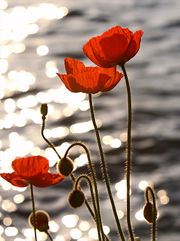
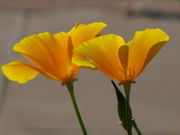
A poppy is one of a group of a flowering plants belonging to the poppy family, many grown in gardens for their colorful flowers.
Poppy flowers have 4 to 6 petals. Petals may be almost any color, and some have markings. Prior to blooming, the petals are crumpled in the bud, and as blooming finishes, the petals often lie flat before falling away. A whorl of stamens is in the center of the flower.
The pollen of the oriental poppy, Papaver orientale, is dark blue. The pollen of the field poppy or corn poppy (Papaver rhoeas) is dark blue to grey. Bees will use poppies as a pollen source.
Poppies belong to several genera:
- Papaver – corn poppy, Opium poppy, Oriental poppy, Iceland poppy, and about 120 other species
- Eschscholzia – California poppy and relatives
- Meconopsis – Welsh poppy, Nepal poppy, and relatives
- Stylophorum – Celandine-poppy or wood-poppy
- Argemone – Prickly-poppy
- Romneya – Matilija poppy and relatives
- Canbya – Pygmy-poppy
- Stylomecon – Wind-poppy
- Arctomecon – Desert bearpaw-poppy
- Hunnemannia – Tulip poppy
- Dendromecon – Tree poppy
Contents |
Uses
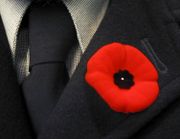
All species of poppies are attractive and most are cultivated as ornamental plants. A few species have other uses, principally as sources of drugs and foods. The opium poppy, (Papaver somniferum) is so widely used, for both drugs and food, that its world production is monitored by international agencies. It is grown for opium and opiates obtained from it, poppy seed for use in cooking and baking, poppyseed oil for both culinary and other uses, and as an ornamental garden plant.
Symbolism
Poppies have long been used as a symbol of both sleep and death: sleep because of the opium extracted from them, and death because of their (commonly) blood-red color. In Greco-Roman myths, poppies were used as offerings to the dead.[1] Poppies are used as emblems on tombstones to symbolize eternal sleep. This aspect was used, fictionally, in The Wonderful Wizard of Oz to create magical poppy fields, dangerous because they caused those who passed through them to sleep forever.[1]
A second meaning for the depiction and use of poppies in Greco-Roman myths is the symbolism of the bright scarlet colour as signifying the promise of resurrection after death.[2] The poppy of wartime remembrance is Papaver rhoeas, the red flowered Corn poppy. This poppy is a common weed in Europe and is found in many locations, including Flanders Fields, the setting for the famous poem by Canadian surgeon and soldier, John McCrae, "In Flanders Fields". In the United States,[3][4] Canada, the United Kingdom, Australia and New Zealand artificial poppies (plastic in Canada, paper in the US, UK, Australia and New Zealand) are worn to commemorate those who died in War. In the United States this is in conjunction with Veterans' Day, in Canada this is part of the Remembrance Day ceremonies, both falling on November 11th, though generally poppies are worn from the beginning of November until that day.
The California poppy, Eschscholzia californica, is the state flower of California.
In Mexico, Grupo Modelo, the makers of Corona beer, used red poppy flowers in its advertising (almost any image it used had poppy flowers somewhere in the image) until the 1960s.
A poppy flower is depicted on the reverse of the Macedonian 500 denars banknote, issued in 1996 and 2003.[5]
The powerful symbolism of Papaver rhoeas has been borrowed by various advocacy campaigns. These include the White Poppy and Simon Topping's black poppy.The name Poppy was taken from the flower.
Poppies (Amapolas in Spanish) are commonly featured as the central flower in Puerto Rican weddings.
Artificial poppies (called "Buddy Poppies") are used in the veterans' aid campaign by the Veterans of Foreign Wars, which provides money to the veterans who assemble the poppies and various aid programs to veterans and their families.[6]
Gallery
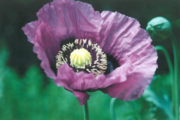 Opium poppy (Papaver somniferum) |
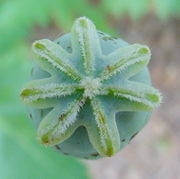 Opium poppy seed capsule |
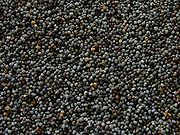 Opium poppy (Papaver somniferum) seeds |
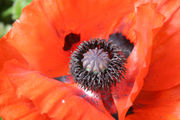 Derbyshire, England, UK, May 2007 |
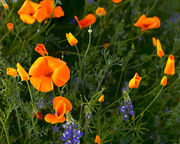 California Poppy |
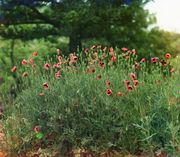 Field of poppies, by Sergei Mikhailovich Prokudin-Gorskii, ca. 1912 |
|
Poppies near Kelling, North Norfolk, UK, June 2002 |
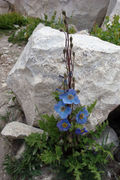 Himalayan blue poppy near Gumburanjon in Zanskar, India, July 2008 |
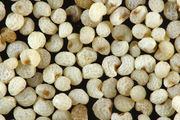 White poppy seeds. There are about 140,000 poppy seeds to the ounce.[7] |
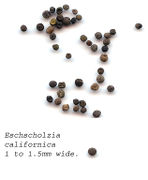 California poppy seeds. |
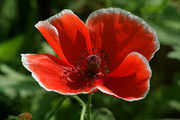 Red poppy flower. |
See also
- Heroin
- In Flanders Fields
- Poppy seed
- Morphine
- Opium
- Remembrance Day
- United Nations Office on Drugs and Crime
References
- ↑ 1.0 1.1 L. Frank Baum, Michael Patrick Hearn, The Annotated Wizard of Oz, p 173, ISBN 0-517-500868
- ↑ Robert Graves, The Greek Myths, 24. 15 p 96, ISBN 0-14-001026-2
- ↑ World Book; Inc (2003). The World Book dictionary. World Book .com. pp. 1622–. ISBN 9780716602996. http://books.google.com/books?id=oPW_pTjpeCQC&pg=PA1622. Retrieved 18 August 2010.
- ↑ United States of America Congressional Record. Government Printing Office. pp. 10121–. GGKEY:8F7NFQJ525R. http://books.google.com/books?id=DbK9zpJ1ipEC&pg=PA10121. Retrieved 18 August 2010.
- ↑ National Bank of the Republic of Macedonia. Macedonian currency. Banknotes in circulation: 500 Denars (1996 issue) & 500 Denars (2003 issue). – Retrieved on 30 March 2009.
- ↑ Veterans of Foreign Wars Buddy Poppy Website
- ↑ Dr. Hutchins, R. E. 1965. The Amazing Seeds. New York: Dodd, Mead and Company./ref>